The Brazos Review: AMD's E-350 Supplants ION for mini-ITX
by Anand Lal Shimpi on January 27, 2011 6:08 PM ESTAMD has been curiously absent from the value netbook and nettop segments since Atom’s arrival nearly three years ago. These markets are highly profitable only for component vendors, as the OEMs that sell netbooks and nettops must survive on very slim margins in order to hit aggressive price points. It wasn’t too long ago that we were shocked by $699 desktop PCs, but to now be able to get a fully functioning portable PC with display at below $300 is impressive. In order for the profit equation to work out however, you can’t simply scale down a larger chip - you need an architecture targeted specifically at the type of very light workloads you expect to encounter in these segments. Underclocking and undervolting an architecture targeted at high end desktops or servers won’t cut it.
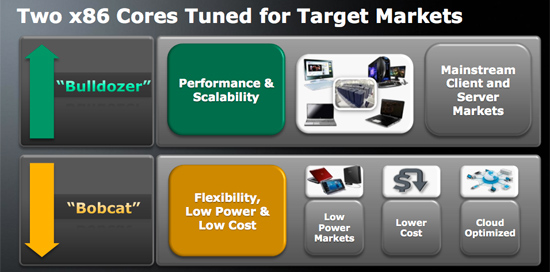
Generally a single microprocessor architecture can cover an order of magnitude of power envelopes. You can take an architecture from 10W - 100W using clock speed, voltage scaling and disabling features (e.g. cutting cache sizes). You can’t efficiently take a 100W architecture and scale it down to 1W. Intel realized this with Atom, and what resulted was a new architecture designed to span the 0.5W - 5W range. Given the constraints of the process (Atom was built at 45nm) and a desire to keep die size down to a minimum (and thus maximize profits), Intel went with a dual-issue in-order architecture reminiscent of the old Pentium - but with a modern twist.
AMD came to the same realization. For it to compete in these value markets, AMD couldn’t rely on its existing Phenom II derived architectures. The Phenom II and its relatives currently span a range of TDPs from 9W to 140W, and at the lower end of that spectrum we’re talking about some very low clock speeds and performance targets. Getting down to 1W was out of the question without a separate design.
What AMD came up with was a core called Bobcat, initially targeted for netbooks, notebooks, nettops and entry level desktops. Architecturally Bobcat is a significant step ahead of Atom: while still dual-issue, it features an out-of-order execution engine making it the Pentium Pro to Atom’s Pentium.
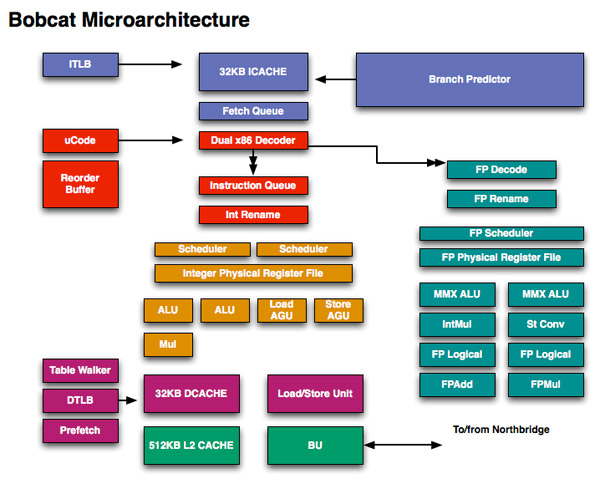
It isn’t just CPU architecture that AMD surpassed Atom with, the first incarnation of Bobcat is an integrated SoC with on-die DirectX 11 GPU. AMD calls this combination a Fusion APU (Accelerated Processing Unit) as it places both a CPU and GPU on a single die. The possible CPU/GPU combinations for Bobcat based APUs are listed in the table below:
| AMD Brazos Lineup | ||||||||
| APU Model | Number of Bobcat Cores | CPU Clock Speed | GPU | Number of GPU Cores | GPU Clock Speed | TDP | ||
| AMD E-350 | 2 | 1.6GHz | Radeon HD 6310 | 80 | 500MHz | 18W | ||
| AMD E-240 | 1 | 1.5GHz | Radeon HD 6310 | 80 | 500MHz | 18W | ||
| AMD C-50 | 2 | 1.0GHz | Radeon HD 6250 | 80 | 280MHz | 9W | ||
| AMD C-30 | 1 | 1.2GHz | Radeon HD 6250 | 80 | 280MHz | 9W | ||
AMD avoided branding its first APUs, they’re simply the AMD E-series and C-series Fusion APUs. The emphasis isn’t on the CPU or the GPU in this case, just the company name and a model number.
| CPU Specification Comparison | ||||||||
| CPU | Manufacturing Process | Cores | Transistor Count | Die Size | ||||
| AMD Zacate | 40nm | 2 | ? | 75 mm2 | ||||
| AMD Thuban 6C | 45nm | 6 | 904M | 346mm2 | ||||
| AMD Deneb 4C | 45nm | 4 | 758M | 258mm2 | ||||
| Intel Gulftown 6C | 32nm | 6 | 1.17B | 240mm2 | ||||
| Intel Nehalem/Bloomfield 4C | 45nm | 4 | 731M | 263mm2 | ||||
| Intel Sandy Bridge 4C | 32nm | 4 | 995M | 216mm2 | ||||
| Intel Lynnfield 4C | 45nm | 4 | 774M | 296mm2 | ||||
| Intel Clarkdale 2C | 32nm | 2 | 384M | 81mm2 | ||||
| Intel Sandy Bridge 2C (GT1) | 32nm | 2 | 504M | 131mm2 | ||||
| Intel Sandy Bridge 2C (GT2) | 32nm | 2 | 624M | 149mm2 | ||||
These APUs do need the aid of an additional chip - the Hudson Fusion Controller Hub (FCH). The FCH adds support for things like SATA, USB, Ethernet and Audio.The Hudson FCH is very tiny measuring approximately 4mm x 7mm for a total die size of around 28mm2.
The combination of these Bobcat based APUs and the FCH is called the Brazos platform.
Late last year AMD invited me to spend several hours with a Brazos system at its brand new campus in Austin, TX. While the preview gave us some insight into what we could expect from Brazos, I didn’t have enough time to really dive in as much as I would’ve liked to.
Earlier this month, AMD officially launched Brazos with hardware expected sometime this quarter. For the past couple of weeks I’ve been testing a Brazos mini-ITX motherboard from MSI and today, it’s time to break the silence and share the results. They are quite good.


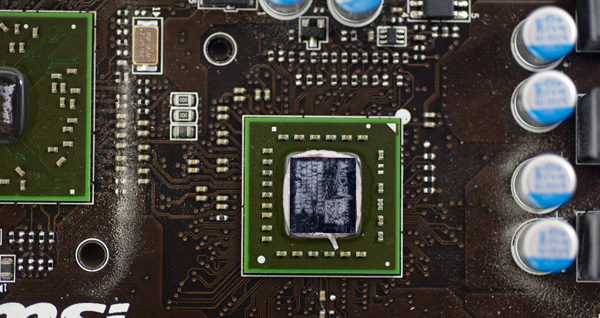
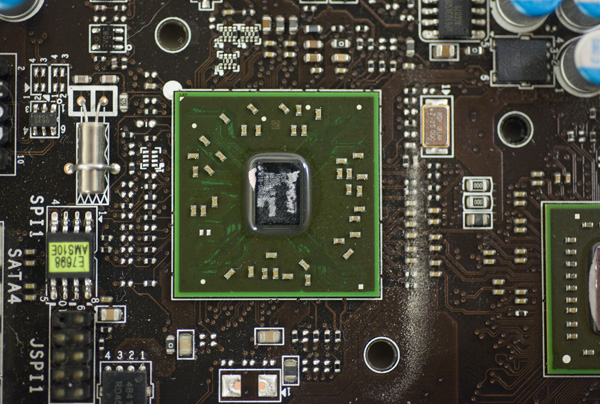
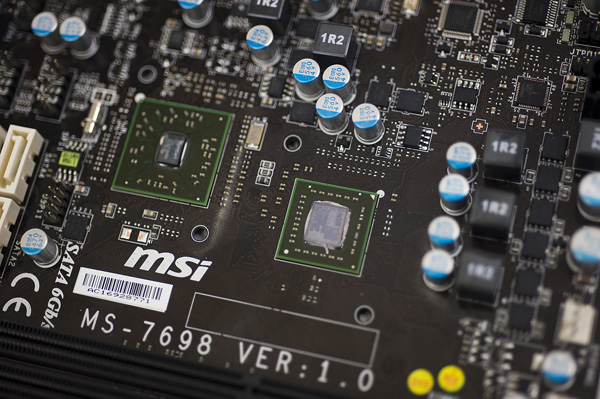
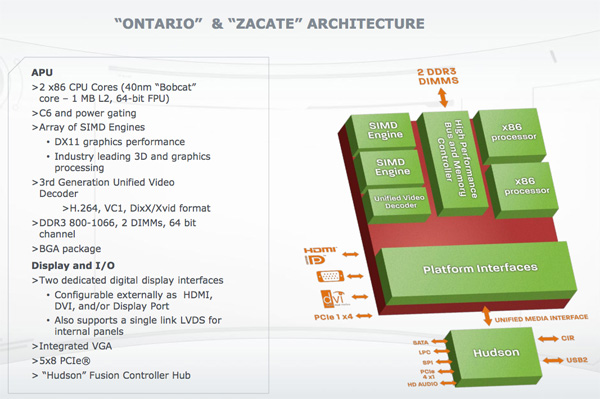








176 Comments
View All Comments
beginner99 - Friday, January 28, 2011 - link
nope. had the exact same thought. SB also offers quicksync which could be very useful on a HTPC.Plus if you factor in total system cost especially if you use a ssd and a nice rather expensive HTPC case, the difference is not that big anymore.
Power consumption on desktop is also not a big issue unless you run it as a server 24/7.
duploxxx - Friday, January 28, 2011 - link
perhaps before you praise the quicksync that much you might want to check at which cpu it is actually supported, yes yes here is our beloved intel again cutting features for certain lower end parts :Dhttp://www.anandtech.com/show/4083/the-sandy-bridg...
sure cpu of G620 will be better then e350 but GPU won't and the E350 is fully passive and probably most will be right at the 100$ mark while there is only 1 board with that kind of price and the 70$ is bulk 1000 pieces price......
but sure you can always select the SB in a month or 2 i.s.o. the brazos, just a matter of positioning, my goal is to replace my atom netbook and that will be done very fast.
never ever will this be same power consumption.... a 35W rated cpu against a 18W get real
sebanab - Monday, January 31, 2011 - link
Llano should take care of our confused friends here.silverblue - Monday, January 31, 2011 - link
It might, but we're still talking a memory bandwidth limitation along with four tweaked Stars cores. For the moment, we don't know how the latter will affect things, but the former certainly presents an issue especially when you think about enabling AA. It'll be a big boost over Brazos, but then again, we expected that. Perhaps it'll have enough grunt to play most modern games with medium and higher details at a good frame rate, but I can't help but feel sceptical.mosu - Sunday, January 30, 2011 - link
totally wrongsilverblue - Monday, January 31, 2011 - link
Come on... a two word answer isn't an answer. :)Shadowmaster625 - Monday, January 31, 2011 - link
If intel charges $70 for budget SB 60 days after launch, I'll eat my socks. That goes against everything they stand for. $100, bare minimum.rs2 - Friday, January 28, 2011 - link
I'm wondering about the suitability of one of these systems for use as a low-volume, low power consumption web server. Obviously performance would not be stellar, but I'm wondering if it would be reasonably acceptable for a low-traffic, non-mission-critical server (for more intense loads I have a quad-core box that I can use, but the power bill associated with running it 24/7 in true server fashion makes me cringe).It seems like the E-350 is about as fast as a 3.6 GHz Pentium 4 from way back when. If so then it seems like it would make a passable server (I'm just thinking basic stuff, like Apache httpd, PHP, and MySQL...maybe Tomcat at most), no?
jjcrandall - Friday, January 28, 2011 - link
supermicro makes a atom based 1u server, so i imagine that the amd platform does a much better job than that.lordmetroid - Friday, January 28, 2011 - link
How hot are are these new processors running? Are they possible to passively cool?